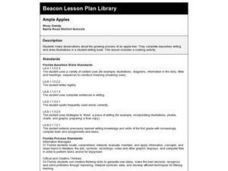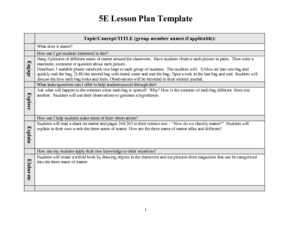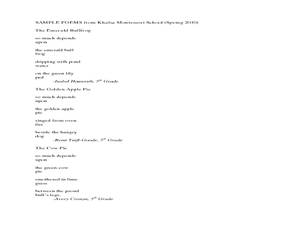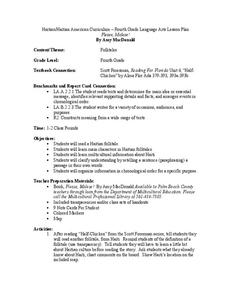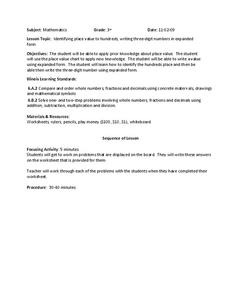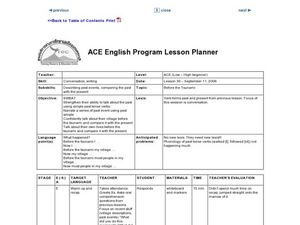Curated OER
Ample Apples
First graders read stories and make observations about the life cycle of an apple tree. They write and illustrate expository text about apple trees and make applesauce.
Curated OER
What Does It Matter?
Young scholars match definitions with vocabulary words and learn basic facts about matter. Then, they see how to determine the physical characteristics of matter. They determine the mass, volume, and density of objects using appropriate...
Curated OER
Biochemical Cycles: Recycling Carbon and Nitrogen
Students construct flow diagrams of the carbon and nitrogen cycle processes. They identify sequences in each cycle that are affected by human impact and present their research to the class.
Curated OER
Spelling Graffiti
Students practice the skill of spelling through using creative art integrated with technology. They use technology by using powerpoint slides for each spelling word. Then students work to create posters for spelling words with colors or...
Curated OER
Narrative Prompt
Second graders are introduced to the style of a narrative writing. After being read a story, they use a graphic organizer to plan their writing. With a partner, they share their ideas and decide on one topic to write about. To end the...
Curated OER
Narrative Prompt - Lesson 2
Second graders review the structure of a narrative piece of writing. Individually, they write a narrative based on their best day of school. After being read different stories, they share their own narratives with the class. They are...
Curated OER
Digital Storytelling: At-Risk Students Find Their Voices
Learners use digital cameras and software to create a digital story which consists of a series of digital images paired with a narrarated soundtrack. They focus on relevant images and a presecribed sequence of steps to provide a vignette...
Curated OER
The Strange Case of Dr. Jekyll and Mr. Hyde: Getting Started with Literature Circles
Students complete novel analysis activities for The Strange Case of Dr. Jekyll and Mr. Hyde. In this novel analysis lesson, students work in literature circle groups to complete close reading activities for the novel. Students keep...
Curated OER
Do They Rhyme?
Students pick out words that rhyme. In this lesson on rhyme, students listen to the teacher read the poem "My Robot Does My Homework" by Kenn Nesbitt and pick out words that rhyme.
Curated OER
ESL Activity - Authentic Cooking Experience
Students encounter imperatives used for the instructions for this cooking experience. They review selected vocabulary terms for food and the process of cooking. Students identify adverbs of sequence (first, then, etc.). They follow the...
Curated OER
Numerical Analysis: Worksheet 12: Comparing Root-Finding Methods
In this root-finding worksheet, students rank numbers in asymptotic order. They identify and discuss the roots of the original function. This four-page worksheet contains approximately 10 problems.
Curated OER
Interning Japanese Canadians
Students create a time line of the Japanese Canadian internment of World War II to the apology of the government in 1997. In this World War II lesson plan, students identify historical events in sequence.
Curated OER
Noam Chomsky
In this famous people worksheet, students read a selection about Noam Chomsky and complete a variety of comprehension activities including but not limited to a synonym match, spelling, writing and sequencing activities.
Curated OER
Family Fables, Facts, and Other True Stories
Students conduct an interview about their family with their parents and/or grandparents. They write a story based on interview facts and create a presentation for the class.
Curated OER
Core Poetry and More
Second graders examine poetry in the context of American History in the four lessons of this unit. They read, write, and edit their own pieces in this unit.
Curated OER
The Red Wheelbarrow
Students explore an imagist poem. In this poetry lesson students write a poem in the imagist's style using "The Red Wheelbarrow" by William Carlos Williams as an example. The poems are read aloud and discussed.
Curated OER
Pigs: Facts And Fun
Students complete a unit on pigs. They take a field trip to the fair and zoo, watch the video of "Charlotte's Web," create a poster, read and analyze "The Three Little Pigs," write a storybook, participate in a reader's theater, and make...
Curated OER
Dinosaurs
Students research and identify the characteristics of a variety of dinosaurs. They participate in a class discussion about dinosaurs, analyze and examine fossils, and conduct research using a variety of sources to write and present a...
Curated OER
Johnny Appleseed, An American Folk Hero
Students explore American folktales. They review the elements of folktales. Students read the folktale of Johnny Appleseed together. They discuss the vocabulary words from the story. Students discuss the differences between the real...
Curated OER
Fun with Making Sentences
Students develop their own children's book in order to develop writing skills. The skills include writing logical and complete sentences. This lesson is important because writing is applicable to many subject areas.
Curated OER
Folktales
Fourth graders read a Haitian folktale. They study main characters in Haitian folktales and explore multicultural information about Haiti. They clarify understanding by retelling a sentence (paraphrasing) and a passage in their own...
Curated OER
Identifying Place Value
Third graders complete math problems. In this place value instructional activity, 3rd graders solve problems that require them to write the place value of a number in expanded form and identify the place value and expanded form of...
Curated OER
Before the Tsunami
Learners practice their conversation and writing skills as they strengthen their ability to talk and write about the past. In this ESL lesson, students narrate a series of past events using past simple verb forms. Learners then...
Curated OER
Technology-commected Folklife Lesson Plan: Fables
Learners discuss ways the stories were alike and different. The teacher demonstrate how to draw a Venn diagram using Microsoft Word. They label the two circles and enter the likenesses and differences on the diagram.
